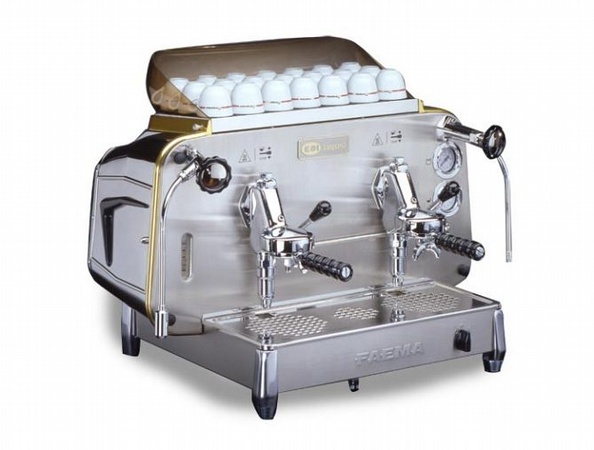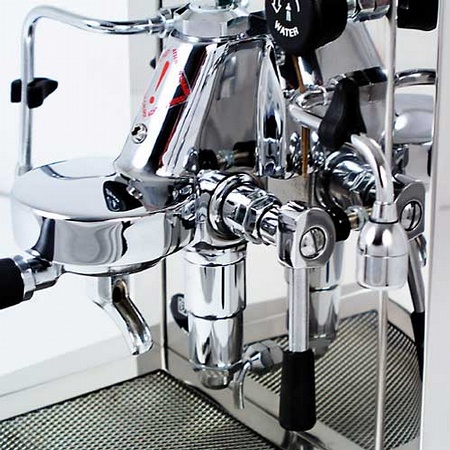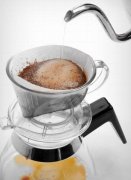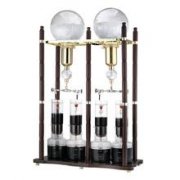The working principle of classic E61 brewing head of Italian boutique coffee machine
The e61 brewer first appeared on the Faema E61 coffee machine in 1961 and is a sophisticated design that has become a classic of espresso machines. Nearly 50 years after its birth, there are still many espresso machine manufacturers equipped with such brewing heads on some models of machines.

What are the advantages of the e61 brewing head that make it popular for so long? Here is a brief introduction to e61 brewing by quoting the information on home-barista.com, hoping to help those who want to understand the structure and principle of e61 brewing head.
Let's first look at the profile of the e61.

Unlike ordinary brewing heads, e61 has two water pipes connected to the boiler (or heat exchanger), the upper one is called the water inlet, and the lower one is called the water return. The hot water in the boiler enters the cavity 1 from the water inlet, heats the boiling head, reduces the temperature of the hot water after heat exchange, and the density of the cooled hot water increases with greater gravity, thus generating downward flow and flowing back to the boiler from the water return port. Hot water circulates naturally in the piping system composed of boiler and brewing head, which is called thermosiphon effect. The boiler heat is used to heat and insulate the boiler head, which is a major function of e61.
Another feature of the e61 is the automatic pre-soak function. The hot water pressure for making espresso is equivalent to 8 to 10 atmospheres. If the water at such a high pressure is suddenly applied to the surface of the coffee cake, it is not beneficial for coffee extraction, so the engineers who design and manufacture coffee machines try to avoid it. On e61, an expansion chamber (chamber 4) is designed to slow down the pressure build-up process. In addition, hot water from the boiler through the water inlet to cavity 1, cavity 2, cavity 3 and then to the water distribution network, to go through twists and turns of narrow pipes, these pipes played a very good role in limiting flow. Therefore, for e61 brewers, the hot water pressure builds up slowly, a process known as pre-impregnation.
Let's take isomac as an example to see how e61 brewers work.

In the picture above, the small handle of the isomac coffee maker is in the closed position, when the water inlet valve is closed, hot water cannot enter chamber 3 from chamber 2, and the cam pushes the pre-soak valve plunger and the discharge valve. Pressures the valve mandrels, the prepreg valve and the relief valve are open.
To make coffee, move the small handle up to the horizontal position, the microswitch behind the small handle is pressed (see below), and the pump starts. At this time, the pre-soak valve and the pressure relief valve are closed, while the water inlet valve is open (the cam pushes against the water inlet valve plunger, see e61 brewing head section). When hot water is injected into each open pipe and cavity of the brewing head, the pressure rises. When the pressure exceeds 1.5 atm, the prepreg valve (expansion valve) opens and hot water enters chamber 4. Thus, the coffee cake is subjected to hot water pre-soaking at 1.5 atm before the hot water fills the chamber 4. Once chamber 4 is filled, the hot water pressure begins to rise again until the desired 8 - 10 atmospheres are reached.

After coffee making is finished, the small handle is moved to a vertical position, the microswitch is closed, the water pump stops, the cam releases the water inlet valve mandril, the water inlet valve is closed, the cam presses down the pre-soaking valve mandril and the pressure relief valve mandril, the pressure relief valve is opened, and hot water with pressure in the cavity, the cavity 3 and the cavity 4 between the brewing filter bowl and the water distribution net is discharged to the coffee machine drain tank from the pressure relief water outlet.
(Source: Douban)
Important Notice :
前街咖啡 FrontStreet Coffee has moved to new addredd:
FrontStreet Coffee Address: 315,Donghua East Road,GuangZhou
Tel:020 38364473
- Prev

Boutique coffee machine recommends coffee made by AeroPress
The structure of the AeroPress is simple: two plastic cylinders are combined into a syringe. Put the broken coffee powder into the cylinder, pour into the hot water, and place the AeroPress on the cup. Next, you need to press hard on the upper cylinder, and the pressure causes the coffee to be squeezed out and into the cup. Finally, what is left at the bottom of the cylinder is dry, flat coffee grounds, which makes it easy to
- Next

Boutique coffee pot introduction ice drop coffee pot total coffee
Low temperature extraction of coffee essence, a completely different taste feeling! Ice drop coffee is said to have been invented by Dutch immigrants on the island of Java. The structure of the ice drop pot is simple, including the upper pot, the middle pot and the lower pot. The ice in the upper pot melts into a drop of water into the middle pot containing coffee powder, and the iced coffee extracted from the lower pot is picked up. The production process is very ornamental, and it is a coffee extraction method that can best reflect the original taste of coffee.
Related
- What is the Philharmonic pressure? How to use Philharmonic pressure to make delicious coffee
- Why does a hand grinder have more fine powder than an electric grinder?
- In addition to the hot mom, what is the difference between the versions of EK43 | ditting and Mahdi ek43?
- What kind of equipment do you need to make coffee by hand? Introduction to novice starter cooking equipment tools
- Espresso needs to be ground how thick and thin scale entry Italian Coffee Machine Bean Grinder investigation and Grinding course
- How much does it cost to open a small private cafe? How much does it cost to learn coffee? How to operate it?
- The difference between the flavor characteristics of hand-brewed coffee and coffee maker is hand-brewed coffee really better than coffee maker? Can I use a coffee machine to make coffee beans by hand?
- The difference between 01 and 02 of hario v60 filter cup what is the difference between 01 and 02 filter cup opening and cooking flavor
- What's the difference between the smart cup and the French kettle? Which is better, the French kettle or the Smart Cup?
- What's the difference between a smart cup and a V60 filter cup? The difference between the taste of smart cup and hand-brewed coffee

